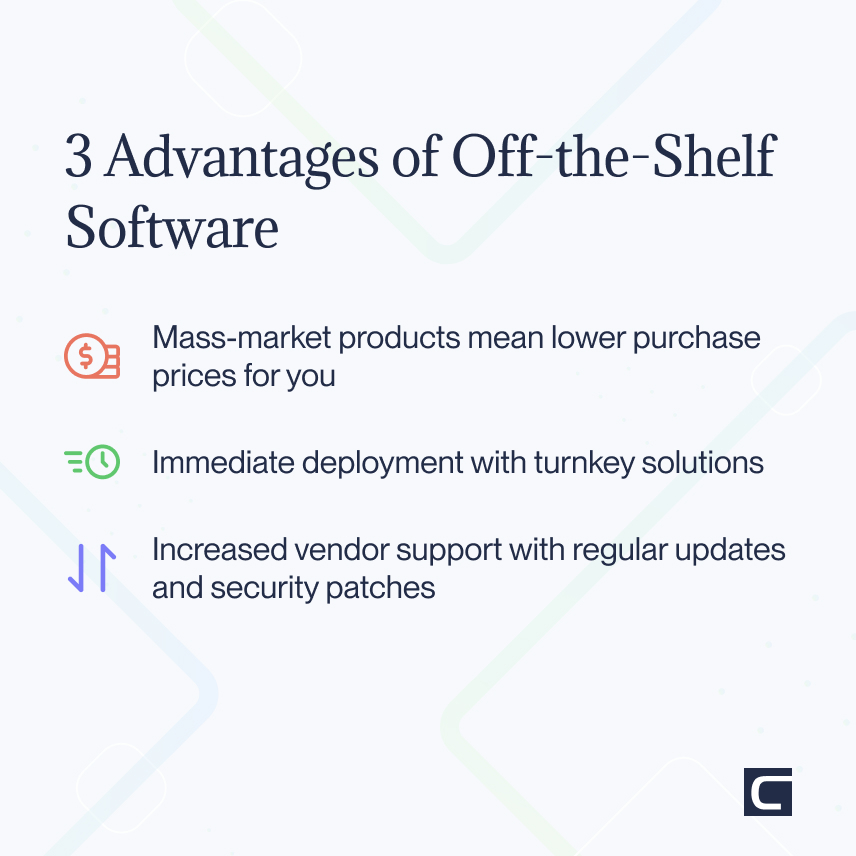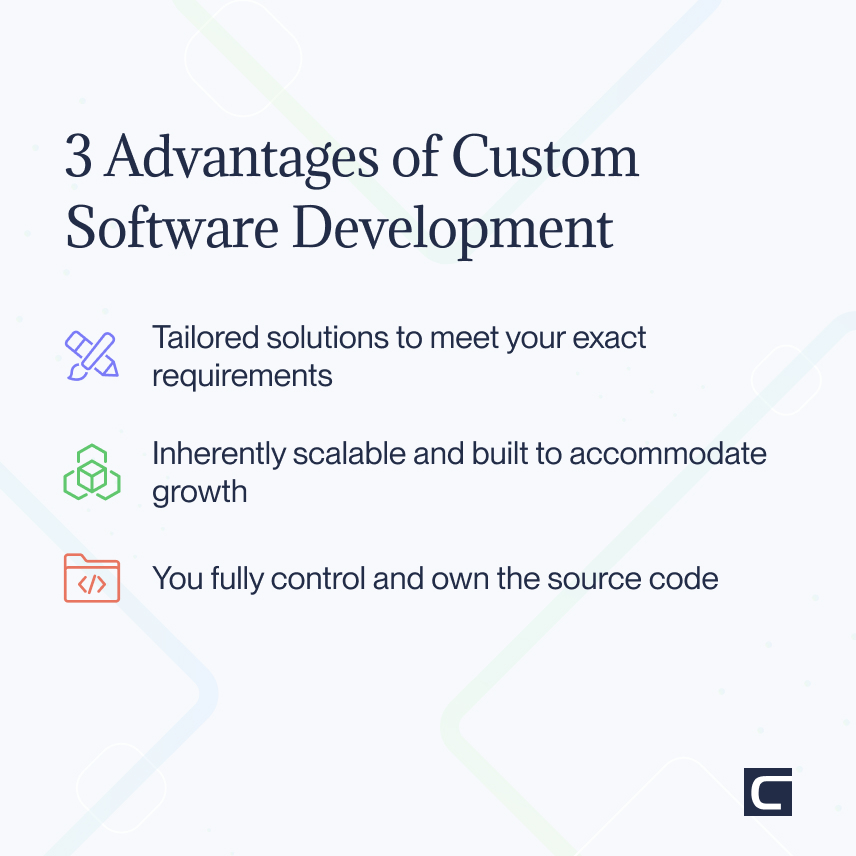Exploring the pros and cons of building custom software solutions vs. choosing off-the-shelf options
If you’re having trouble deciding whether to invest in off-the-shelf software solutions or opt for custom software development for your business, you’re not alone. It’s completely normal to feel a bit overwhelmed by all the options and variables to consider. On the one hand, software as a Service (SaaS) solutions appear budget-friendly and convenient at first glance. However, they could end up costing you more in the long term.
Conversely, developing software involves managing time, finances, and significant resources. It’s much like deciding between investing your money on your own versus seeking advice from a financial advisor or choosing between a DIY home improvement project and hiring a professional. Each option has its set of pros and cons.
So, how can you be certain whether to handle things yourself or pass them on to someone else? Let’s explore the advantages and disadvantages of building versus buying off-the-shelf software to help you figure out which option best suits your business needs.
Pros and cons of purchasing off-the-shelf software
There are times when choosing to buy software is truly the optimal choice, especially when other aspects of your business demand your focus. Additionally, given the array of specialized SaaS options, in today’s market, finding a reliable partner has become easier. Here are some pros and cons of purchasing software vs. creating it from the ground up.
Advantages of purchasing off-the-shelf software

Cost-effectiveness: Off-the-shelf software is budget-friendly due to its production and distribution. With development costs divided among users, prices remain competitive, making it a suitable option for small to medium-sized businesses with tight IT budgets.
Instant implementation: Implement software solutions swiftly with plug-and-play features offered by made products. Avoid delays associated with custom projects. Seize market opportunities quickly—a great fit for time-critical scenarios.
Supplier support: Pre-packaged software includes maintenance and support services. Whether it’s updates or security patches, your supplier has you covered—customer assistance is a phone call away. Your software will stay up-to-date and dependable for your business requirements.
Challenges with purchasing off-the-shelf software
Lack of customization: These software programs are created to cater to a broad audience which may not perfectly match every business’s needs or processes. This could lead companies to adapt their workflows to accommodate the software, potentially resulting in inefficiencies or compromises in their operations.
Underutilized features: Many businesses only use a portion of the features in ready-made software packages. Despite this, companies end up paying for the full feature set even if they don’t utilize all of it. This can give the impression that off-the-shelf software is cost-effective, especially if unused features clutter the user interface and complicate the user experience.
Dependency on vendors: When businesses rely on off-the-shelf software, they become reliant on vendors for functions. This reliance could involve depending on vendors for updates and new features or facing disruptions if the vendor discontinues the product or goes out of business. Additionally, businesses may find themselves tied by long-term agreements or encounter costs when trying to switch to options.
In conclusion, while off-the-shelf software can offer a budget-friendly solution for businesses, it’s important to carefully consider its benefits alongside potential limitations and dependencies. Understanding these elements is crucial to making choices that are in line with your company’s requirements and overarching objectives.
Exploring custom software development
Creating custom software involves developing solutions tailored to a business’s needs and objectives. Unlike mass-market software, custom software is designed to address enterprises’ challenges and requirements.
Benefits of custom software development

Personalized solutions: Custom software is designed to match a business’s requirements, ensuring that every feature and functionality aligns with the company’s goals. This tailored approach enables integration into the company’s operations.
Scalability: Custom software is flexible and capable of adapting to a business’s growth and changing needs. It can be expanded as the company evolves, allowing it to keep up with opportunities and challenges for long-term relevance.
Ownership and intellectual property (IP) value: Investing in custom software grants ownership of the source code to the business. This ownership provides control over the software creating an asset for the company. Having software sets a business apart from competitors, offering a competitive edge.
👋 Ready to start your software development project and need expert advice?
With our industry-leading software development services, Curotec can help bring your vision to life. From simple applications to complex systems, our team has the expertise to guide you through your software development project.
Challenges of developing custom software
Increased expenses and time commitment: Creating a custom software solution from scratch demands an investment of resources both in terms of time and money. The expenses involved in designing, building, testing, and launching a custom application can be considerably higher than opting for an off-the-shelf solution.
Continual upkeep: When using custom software, the company bears the responsibility for maintaining, updating, and resolving issues. This requires either a team with the skills or ongoing partnerships with external developers, both of which come with added expenses and managerial oversight.
Project uncertainties: The process of developing custom software is intricate and comes with its share of uncertainties, such as exceeding budgets, missing deadlines, and not meeting project goals. Custom software endeavors can face obstacles without leadership and a well-defined project strategy.
Important factors to consider when making decisions
When deciding between purchasing off-the-shelf software or investing in custom software development, it’s crucial to have an understanding of your company’s current situation and future goals. This choice not only impacts your business capabilities but also influences its strategic direction, financial well-being, and operational efficiency.

Business requirements and objectives: Analyze your company’s processes, future plans, and strategic goals. Understanding these aspects will help determine whether a personalized custom software solution or an off-the-shelf software package is more suitable for aligning with your company’s path.
Financial resource allocation: Evaluate your budget limitations. Assess whether your company can handle the ongoing costs associated with each option. It’s also important to consider whether your organization has the expertise to implement purchased software or develop and maintain a customized solution.
Existing solutions in the market: Researching the availability of off-the-shelf software solutions that cater to your specific needs is vital. In some cases, the ideal tool for your business may already be on the market. If, on the other hand, the market does not offer a ready-made solution that fits your business needs, you may need to consider developing custom software to bridge the gap.
Risk assessment: When assessing the risks associated with purchasing and building software, it’s important to consider security, scalability, and the provider’s reliability. This step helps avoid issues that might impact your business operations or data security.
Deciding between buying and building software

When to purchase: Opt for packaged software if it efficiently meets your business requirements, particularly for solutions offered by SaaS companies. A good example is Best Buy’s implementation of Salesforces Commerce Cloud, which allowed for e-commerce improvements without custom development.
When to build: Consider choosing custom software development if your business heavily depends on software features or if current solutions do not fully meet your requirements. Netflix’s Open Connect, a personalized content delivery network, illustrates how custom development can greatly improve business operations and customer satisfaction.
Hybrid approach – Best of both worlds: Mixing and matching off-the-shelf with custom components, as Zapier does with its customized workflows linking different software, can offer a middle ground. It lets you deploy quickly while tailoring to your specific needs. When purchasing off-the-shelf software, choosing the vendors and software solutions requires thorough research, careful contract negotiation, and strategic planning for implementation to ensure a seamless and efficient integration process. Custom software projects should follow project management practices, such as selecting a development team (either in-house or outsourced) and focusing on the quality and scalability of the end product from the beginning.
Take charge of your software strategy
When deciding between buying or building, think about what your business really needs and what you can handle financially and logistically. Consider all angles—from security to scalability to vendor reliability. This isn’t just a choice—it’s about setting your business up for success. Remember, there’s no one-size-fits-all answer; the optimal choice varies depending on each business; thorough research and seeking expertise from IT professionals can help you make the best decision for your unique situation.
Deciding between creating custom software and choosing an off-the-shelf solution can feel overwhelming—there’s no one-size-fits-all answer. At Curotc, we recognize the challenges and factors involved in each option. Don’t let uncertainty hold back your business’s growth potential. Whether you’re considering an off-the-shelf solution for its cost-effectiveness and simplicity of implementation or a tailor-made software that fits seamlessly with your business operations, we’re here to offer guidance.
Let’s talk about your software requirements so you can make an informed decision that matches your business objectives and operational needs. Arrange a consultation to begin enhancing your software strategy and find the path to your business success.



